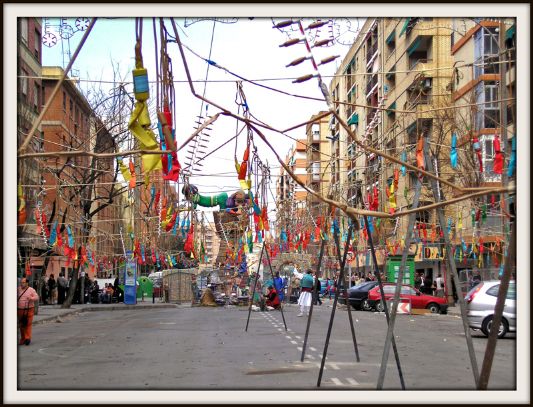
Still haven't visited Valencia in Fallas? Isn't it about time?..... The month of Fallas will get underway this Sunday, March 1 as soon as the Crida Opening Ceremony finishes in front of the Serrano Towers. If you think you can make it, it will be kicking off at 20:00 hrs.
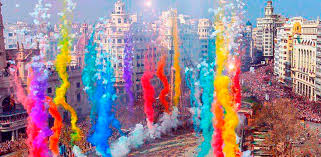 Fallas is a festival that is attracting more and more people every year. I must admit the first time I came to Valencia and saw “Fallas” I was blown away, excuse the pun, as I was amazed at how much money literally went up in flames and the sheer quantity of gunpowder that was used in fireworks and bangers throughout the streets, literally millions and millions of euros. These sculptures are so big that they actually have routes paved out so you can travel through them and see all the details close up. Over 370 full-scale Fallas and 368 children’s Fallas are mounted throughout the city, and many of these reach extravagant heights. Photos do not do them justice at all. It is something that must be seen in the flesh to really take in their magnitude and artistic creativity. They are well and truly works of art, which take a year to build and 30 minutes to burn to the ground. It is without a doubt the best festival in Spain by far. Nothing comes close.
Fallas is a festival that is attracting more and more people every year. I must admit the first time I came to Valencia and saw “Fallas” I was blown away, excuse the pun, as I was amazed at how much money literally went up in flames and the sheer quantity of gunpowder that was used in fireworks and bangers throughout the streets, literally millions and millions of euros. These sculptures are so big that they actually have routes paved out so you can travel through them and see all the details close up. Over 370 full-scale Fallas and 368 children’s Fallas are mounted throughout the city, and many of these reach extravagant heights. Photos do not do them justice at all. It is something that must be seen in the flesh to really take in their magnitude and artistic creativity. They are well and truly works of art, which take a year to build and 30 minutes to burn to the ground. It is without a doubt the best festival in Spain by far. Nothing comes close.
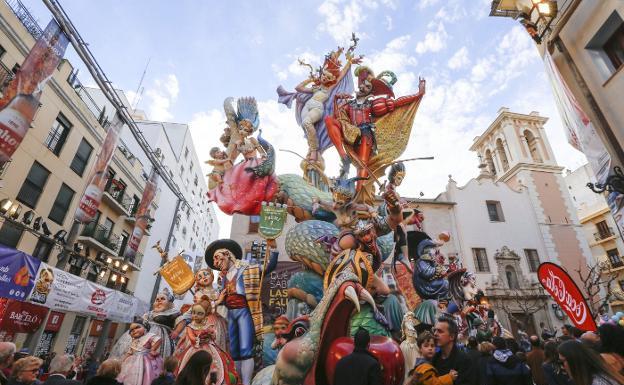
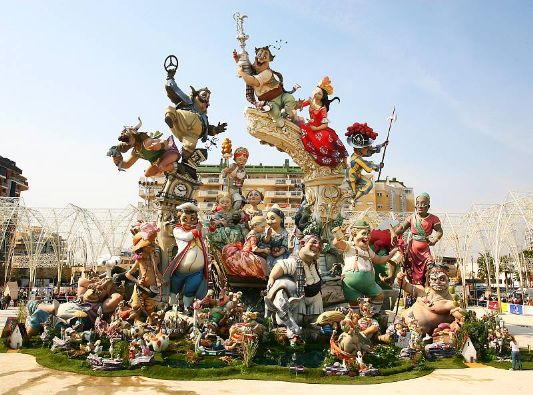
Well in excess of €4 million euros are spent by the Valencians on bangers and firecrackers which are constantly being blown up day and night throughout the month of March. However when you look at the big picture, the direct and indirect economic impact of Fallas for Valencia is well over 600 million euros, so it is certainly well worth it for the local economy. Long live the Fallas! I must admit no one throws a party like the Valencians do! Nonetheless, the vast majority of the Valencianos under 40 have no real idea why they are celebrating Fallas they just do!
.jpg)
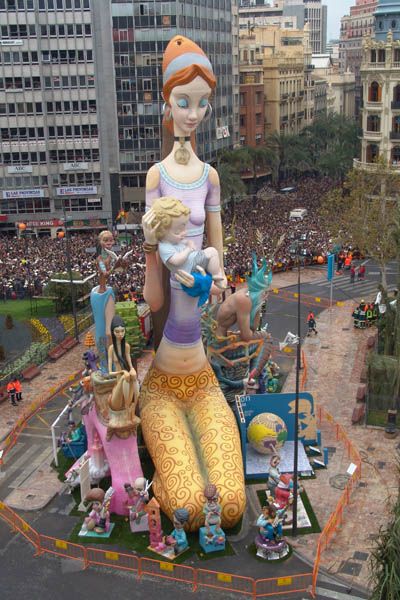
Like many Spanish festivals, Las Fallas was, in its origin, a simple pagan ritual that celebrated the Spring Equinox and the subsequent coming of summer. The religious undertones and celebratory association with Saint José, the patron saint of carpenters, was added later by Spain's ultra-Catholic leaders. The history goes a little something like this:
In 15th-century Valencia, as autumn crept in and the days began to get shorter, artisans and carpenters had to spend the last few hours of the workday working by the light of oil lamps hung from crafted wooden "parots." When spring arrived, the days naturally became longer and it was evident that the pleasant days of spring and summer were just around the corner. No longer needing the lamps, artisans took to ceremoniously burning the "parots," standing them up in the middle of wood shavings, extra cuts of lumber and old junk accumulated with spring cleaning.
At this point, during the morning of 18 March, rag dolls were strung across city streets from window to window, or small platforms were set up against walls displaying one or two figures (ninots) that referred to an event or to certain individuals that were particularly deserving of public derision. Throughout the day, children and young people collected objects to be burnt on these bonfires called “fallas”. All were burnt the evening before St. Joseph's Day in the midst of much celebration.Over time, these workers added a creative touch to the ritual, decorating the lamp post with rags and a hat, thus giving it semblances of a doll or human form; these figures, often depicting someone from the neighbourhood, that came to be known as a Ninot Falla (Doll Fire). The evolution of the festival of Las Fallas as we know it today took place during the second half of the 18th century.
The next day, devout Valencians and carpenters attended their local churches in honour of their patron saint. Families also celebrated the saint's day for anyone called José (also known as Pepe) with cakes, fritters and anisette. It was a time of widespread, neighbourly festivities.
The first documentation concerning the fallas is an official letter sent to the mayor of the city of Valencia prohibiting the placing of monuments (especially of a theatrical nature) in narrow streets close to facades. This measure adopted by the city's police for the purpose of fire prevention led the inhabitants to set up their fallas only in wide streets or at crossroads and in squares and, unexpectedly, led in the long term to an important transformation. Although the fallas continued to have a horizontal, theatrical structure made up of two parts (a platform and a scene arranged on it), they started to be placed on wheels so that they could be moved to the centre of a street or square. As they were no longer placed against a wall, the design changed to make it possible to view them from all sides. This created much greater freedom of construction and invited the inclusion of messages all around them.
For a long time, the term falla was used indistinctly for the torches, bonfires, rag dolls and platforms, but gradually the term came to be restricted to the satirical pyres that exposed vices or prejudices to public scorn. These fallas gave rise to great expectation and the local inhabitants came en masse to view them. The structure was usually prismatic and erected on a square, wooden base decorated with painted frames and canvases or panels to conceal the combustible materials underneath. The figures included in the scenes were usually dressed in old clothes. As with the popular theatrical performances of the miracles of St. Vincent, these satirical fallas usually came with verses that were hung on nearby walls or on the pedestals and that related to the subject of the falla. By the middle of the 19th century, these verses started to be printed and bound, giving rise to the booklet called the llibret. This made it possible to develop the subject much further.
The special characteristic of the satirical fallas is that they represent a reprehensible social action or attitude. They have a specific subject and aim to criticise or ridicule. They are more than mere bonfires or pyres because they show scenes referring to people, events or collective behaviour that their makers - the falleros - consider should be criticised or corrected. The two most popular subjects for falleros in the 1850s were eroticism and social criticism.
In 1858, the falleros in the Plaza del Teatro were officially prohibited from erecting a moving falla with a direct allusion to social inequality with verses written by Josep María Bonilla, but they went ahead, all the same, the following year. The press gave the name of "erotic falla" or "anti-conjugal tendency" to the many fallas that alluded to racy or risqué subjects with verses using double-entendres that reflected a hedonistic, lewd mentality. Bernat i Baldiví wrote llibrets on such subjects but the best-known is that written by Blai Bellver for the falla in the Plaza de la Trinidad in Xativa in 1866. This was called "The Cross of Marriage" and was severely condemned by the Archbishop.
Throughout the 19th century, the Town Council and the authorities, in general, tended to disapprove of these fallas. Their policy of repression, which aimed to modernise and civilise the city's customs by eradicating popular celebrations such as the Carnival and the Fallas, was applied with rigour during the 1860s when heavy taxes were levied on permits for setting up fallas or playing music. This led to a reaction in defence of local traditions and, in 1887, the magazine La Traca awarded prizes to the best fallas. The initiative was continued by an association called Lo Rat Penat. This explicit support from civil society provoked competitiveness amongst the different neighbours' committees, stimulating fervour for the fallas and encouraging artistic creation. Criticism did not disappear from the subjects of the fallas (in some cases, it was politically radical) but a new trend arose favouring formal structural and aesthetic concerns
.
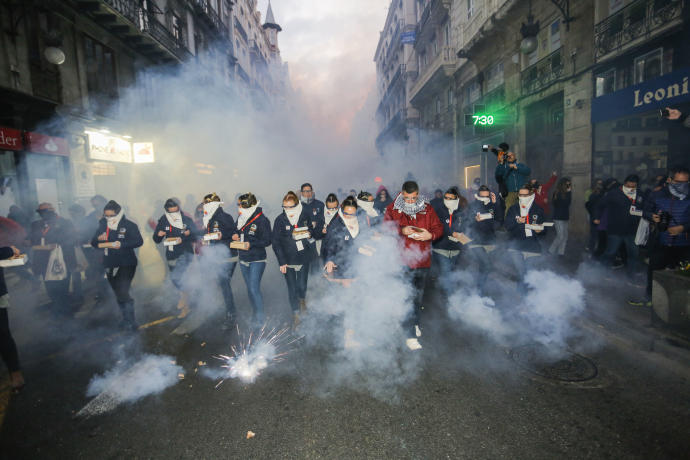
Eventually, though rather reluctantly, the City Council of Valencia took over from Lo Rat Penat and awarded the first municipal awards for the fallas at the end of the festivities - one for 100 pesetas, and another for 50 pesetas. The social climate was not only in favour of this initiative but demanded it. A wide range of organisations was involved - cultural, recreational, civic, sporting, political and for workers - and all of these helped to promote the fallas during the first decade of the century. In return, the fallas increasingly devoted their attention to exalting local values, resulting in a growing association between the festivities and Valencia as their centre. From the start of the 20th century, the fallas no longer maintained the dual structure of platform and scene. A new concept took over in which the figures were no longer the most important part. The fallas now basically comprised three different elements - a low base with various platforms for the different scenes, a central body holding up the monument and a top.
The latter usually comprised a large, allegorical figure, condensing the topic of the whole falla and summarising the scenes below it.
The falla did not only contain a scene set against a background but content was expressed in the whole of the sculpture and had to be deciphered by walking all around the falla looking at it from top to bottom. Fallas had become lavish, majestic and imposing - large enough to be seen from a distance. The competitiveness introduced by the awards meant that the artists strove to produce monumental, elaborate creations.
In 1927, the Valencia Atracción association for the promotion of tourism organised the first Falla Train to bring emigrants from Valencia living in other Spanish provinces back to their home town for the festivities. This was so successful that Valencian society became even more devoted to its fallas and the number of monuments constructed grew and grew. The festivities soon came to require better organisation. The General Association for the Valencian Fallas and the Central Fallas Committee were created to represent the commissions and to organise the celebrations.
An article published in 1935 by Y. Llopis Piquer and entitled "How the fallas are prepared" describes the production of a falla in detail.
"The most important elements are cardboard, plaster and wax, without forgetting the wood of the frames and the metal mesh covered with sacking for the large figures."
Using these simple materials, the Valencian artists emulate the large, long-lasting creations of sculptors, showing their skill in the production of grandiose monuments.
The most difficult and complex task is the construction of moulds for the heads. These are based on clay models which are then cast in plaster and subsequently in wax to give heads that are then completed by adding a moustache, a squint or a sneering expression to give a non-human touch and turn them into the characters featured in the falla.
The bodies are easier to build. The cardboard is pressed while wet onto plaster moulds and then shaped, an essential skill for any up-and-coming falla artist. And a further clay mould is made resulting in yet another human incarnation which will then be completed with physical distortions and material additions. This is the basic method used for turning out the multiple characters of the fallas.
The most difficult part is to paint the wax. There are few artists who are capable of injecting life into the figures by the use of colour but, by dint of experience and perseverance, miracles take place. What still remains to be done? The bodies are then placed on a wooden strut which serves to attach lightweight materials such as straw, cloth, sawdust and wax. The figures are finally erected on the actual day of the plantá when the fallas are placed in their final locations and the frames and mouldings are hammered on. Once in the streets, the figures blend with city life and, in the night-time darkness, observers can be forgiven for not being able to distinguish between what is real and what is fantastic.
It is no exaggeration to say that almost every street corner has its own falla and fallas commission. During the festivities, Valencian women wear their best traditional clothes and parade through the streets in colourful pageantry under their fallas standards to the sound of regional music.
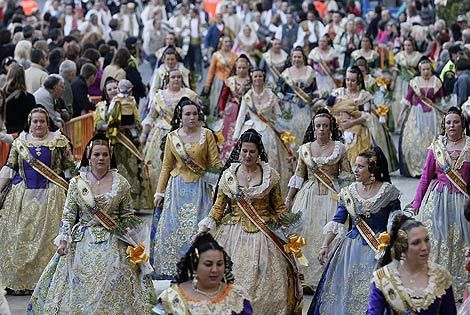
At midday, each falla stages its own daytime-fireworks display, harmonizing the booming sounds of rockets with the smell of gunpowder. They are basically synchronised explosions that vibrate through the entire city, it sounds like a war zone!
At night there are spectacular fireworks displays that brighten up the night-time sky.
The flower offering to the patron saint of Valencia, Our Lady of the Forsaken, (la Ofrenda) is staged on two consecutive days. Thousands and thousands of flowers are placed over a wooden structure that serves as the framework upon which her image is formed. This is located in front of the Basilica and the entire Plaza is perfumed with the fragrance of endless bouquets of flowers. Almost 100,000 Valencians take part in the procession.
.jpeg)
.jpeg)
And of course, every day at five o´clock in the afternoon there is an important bullfight within the framework of the March Bullfighting Fair. On the night of the 19th, Valencians burn down their creations, saving only what is known as the "Ninot Indultat", or the “reprieved figurine”, which becomes a museum piece. The children’s fallas are burnt at ten in the evening, with the exception of the first prize in the children’s category, which is set alight at 22:30 and the city council children’s falla, which goes up in flames at eleven.
At twelve o’clock midnight, preceded by a grand fireworks display, the large fallas are set to the torch.
The entire city is filled with flaming fallas. At 12:30 am the first prize Falla is burnt and at 01:00 am at night the Falla in the Plaza del Ayuntamiento is set alight, symbolically finishing for another whole year this semi-pagan, semi-patriotic, semi-religious fiesta that stirs the hearts of the Valencians.
On the day after the ‘night of fire’, a few marks on the asphalt are all that remains of the falla that stood so proudly the night before. The town council spends all night cleaning the City and removing the rubbish and the remains. It is almost a military event, synchronised to perfection. The following day you would never have guessed what happened the night before. On this very same day, the next fallas campaign gets underway.
.jpg)
Each falla elects their own “Fallas Queen” from among the Fallas Maidens who form the court of honour for that particular Falla. Towards the end of the year, they present one of these ladies - not necessarily their Fallas Queen - in the competition from which the judges will choose the thirteen Valencian women who will make up the court of honour for the Valencian Fallas Queen; “Fallera Mayor” of the entire city of Valencia. Children’s fallas follow the same process.
The Fallas are a feast to which people from all walks of life can contribute. No one, even if they try, can come to Valencia during this time of year and stay on the sidelines. The catafalques are there in the street. The parades never end, whether the falleros happen to be marching to collect their prizes, offering flowers, coming to the deafening midday sound fireworks sessions, seeing fireworks at night, or listening to outdoor concerts in the streets. Food and drink are everywhere, with typical pastry stand on every corner. The noise is sometimes too much for people used to quieter quarters, but there is no doubt about it. Valencia welcomes everyone with open arms and encourages everyone to join in with the festivities. So as the days go by I will be posting Mascletas, Photos of Fallas as and when they go up, and anything else related to this unique and fantastic festivity.
